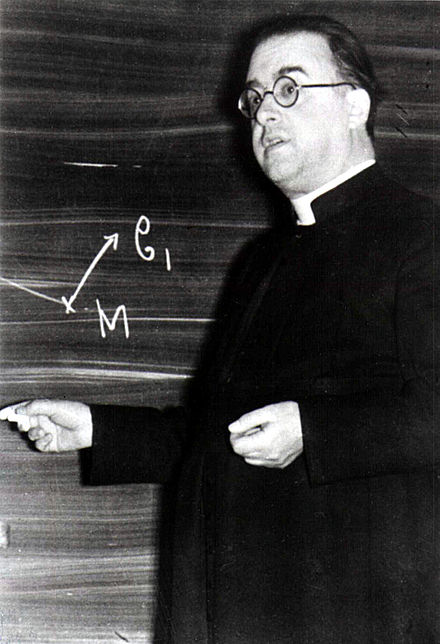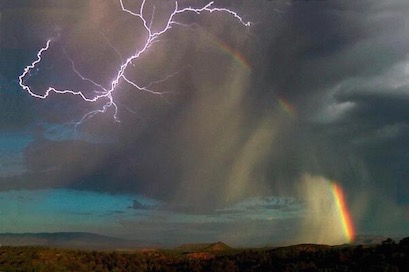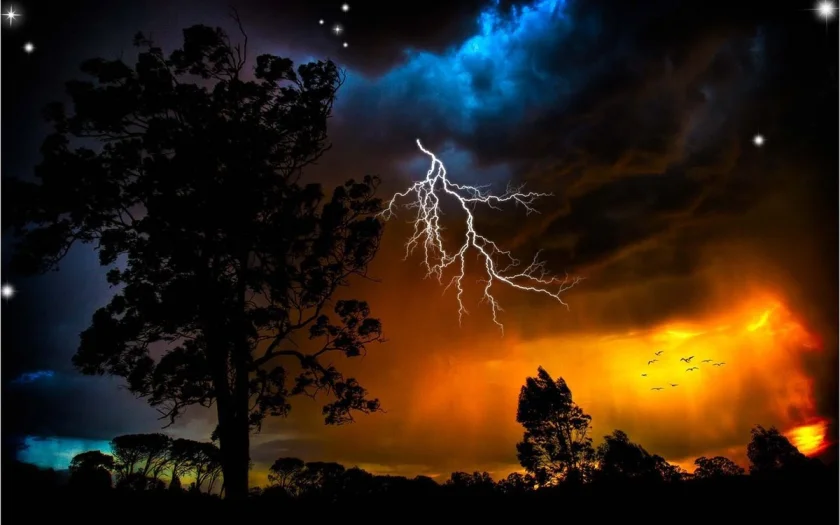 In January 1933 a Catholic priest, Msgr. George Lemaître, a mathematician, astronomer and professor of physics, traveled with Albert Einstein to California for a series of seminars. After Msgr. Lemaître detailed his “big bang” theory, Einstein stood up, applauded, and said, “This is the most beautiful and satisfactory explanation of creation to which I have ever listened.”
In January 1933 a Catholic priest, Msgr. George Lemaître, a mathematician, astronomer and professor of physics, traveled with Albert Einstein to California for a series of seminars. After Msgr. Lemaître detailed his “big bang” theory, Einstein stood up, applauded, and said, “This is the most beautiful and satisfactory explanation of creation to which I have ever listened.”
A Day Without Yesterday

Msgr. Lemaître (1894-1966) concluded that the “red shift” in the universe was a Doppler effect, and therefore that the universe was expanding from a central point. He proposed a theory that the universe is constantly expanding. In the kind of expansion we see every day an object expands into space formerly occupied by something else. Msgr. Lemaître‘s idea was different. He proposed an intrinsic expansion whereby the scale of space itself changed, carrying the early universe with it. It did not require space to exist “outside” the universe.
Msgr. Lemaître argued that, if the universe is expanding, as we go back in time the universe recedes, so its stars and planets were closer together. If we go back far enough, we reach a time when the universe was in an extremely compact and compressed state. Msgr. Lemaître called the origin of the universe a day without yesterday.
From a Point to a Universe
During the 1980s, following on Msgr. Lemaître‘s intrinsic expansion, three topflight astrophysicists, Stephen Hawking, George Ellis, and Roger Penrose, published their “big bang” theory. According to their calculations, time and space had a finite beginning, about 13.7 billion years ago. Before then, the universe did not exist. No space, no time, no matter, no energy. Then, suddenly, the entire universe began, orders of magnitude smaller than the period at the end of this sentence.
Holy Mother Church has a motto, ex nihilo, nihil fit. From nothing, nothing comes. From “no space, no time, no matter, no energy” standard model physics provides no possibility of random generation. Only an entity of infinite intelligence and power living as pure spirit could create from nothing. God began his universe with an awesome show of power. That phenomenally tiny, dense, hot point contained all the matter for our own Milky Way galaxy, with at least 100 billion stars, and 100 billion other galaxies like it. A black hole that collapsed to a geometric point in space where mass is compressed to infinite density and zero volume would require infinite power to de-compress and expand. “With God all things are possible” Mt 19:26. As the tiny universe expanded and cooled, open space appeared.
However, the universe is expanding, not from a single point, but from every point in the universe simultaneously. Msgr. Lemaître held, and the intrinsic expansion consensus among astrophysicists agrees, that as the universe expands the galaxies are not moving through space, but rather moving in space, because space is also moving. In the famous analogy, the universe is like a loaf of raisin bread dough. As the bread rises and expands, the raisins move farther from each other because they are still stuck in the expanding dough.
In Msgr. Lemaître‘s intrinsic expansion the universe has no center. However, Talmud Yoma 54b says that Jerusalem was the very center of creation. The most important object in Jerusalem was the Ark of the Covenant. It stood in the Holy of Holies on a bedrock called the even shtia, the Foundation Stone, the foundation of the universe, the point at which our Father began the act of creation. Can Msgr. Lemaître and Talmud Yoma 54b both be true simultaneously? Certainly they can. God‘s intelligence is infinite, ours is finite. He created and designed the universe in ways far, far above our understanding. Rabbi Yeshua taught us, “With men this is impossible, but with God all things are possible” Mt 19:26.
The intelligence needed to make God‘s intrinsically expanding universe elegant also is necessarily infinite. Newton’s physics revealed the unity of the earth with the entire universe. Maxwell’s equations revealed the unity of electricity, magnetism and light. Einstein’s theory of relativity revealed the unity of space and time. Bohr, Heisenberg, Schrödinger, Born, Dirac, Pauli and others discovered that the universe is built on quantum mathematics that unify particles and waves.
To understand this, we can start with quantum computers. They use the mathematics inherent in the universe itself to solve problems. A quantum computer doesn’t really compute! It sends mathematical questions into a hyper-dimensional reality. The universe itself “does the computations” because the answers are already there.
How does that work? The universe is made of quantum phenomena that constantly try out every possible combination and permutation of atomic spin states and subatomic particles, and derives the combinations that produce the lowest level of chaos (lowest energy state).
Since the 1980s, several assumed variables in the Hawking-Ellis-Penrose equations have been changed to make the numbers match new findings. This updating is inevitable as astrophysicists discover new information, and confirms the consensus among astrophysicists that the Big Bang actually occurred.
Some astrophysicists, perhaps embarrassed by how neatly the Big Bang fits in with God’s creation of the universe, now say the current model of the Big Bang would have resulted in a universe that collapsed soon after its formation.
But this only strengthens the case for God. While today’s most brilliant astrophysicists are struggling to produce even a mathematical model of how the universe came to be, God not only solved all the mathematical and physical problems but actually brought the entire magnificent universe into being, with matter from the big bang settling into a solar system far more precise than a Swiss watch.
Why is There Something?
“Why is there something rather than nothing?” Science has no explanation for the big bang because it resolutely restricts its observations to the corporeal world. Observers who see both the spiritual and corporeal aspects of God’s creation understand much more comprehensively what actually occurred.
Atheist scientists who do not seek the most probable explanation, but instead the most probable explanation that excludes God, are doing religion, not science, since they are making definitive statements about God. Since they restrict their observations to the corporeal world, their conclusions about God, who lives as pure spirit, are not the result of their expertise and observation but are private opinions of no greater value than anyone else’s private opinions.
Dark Energy
Astronomers now realize that the universe’s rate of expansion is increasing. They attribute it to “dark energy,” an irreducible energy associated with space itself said to represent about three-quarters of the universe’s total mass and energy. Astrophysicists say the expansion of the universe had been slowing due to the inward pull of gravity until perhaps 5 to 7 billion years ago. After that it began to accelerate. Was the dark energy in the single dimensionless point inactive for billions of years? What made it suddenly become active way out there in deep space? Or did the dark matter first come into being 5 to 7 billion years ago? What brought it into being? Again the only tenable hypothesis is an entity of infinite power and intelligence living as pure spirit outside of space and time that could act on unimaginable quantities of matter and energy at unimaginable distances far outside the known laws of physics.
Why the Universe Continues
If our atheist astrophysicist friends still aren’t sure how the universe was created, perhaps they can explain what holds in continuing existence. We might expect that entropy, the gradual degradation of matter and energy in the universe toward inert uniformity, would have ended the universe by now, but it has continued, scientists say, for nearly 14 billion years.

Carl Olson addresses the question, Are The Gospels Myth?
Father Spitzer on Stephen Hawking’s View of Heaven 14:46
Dr. Stephen Barr: Modern Physics, the Beginning, and Creation
